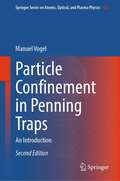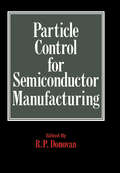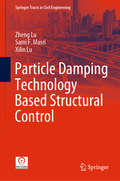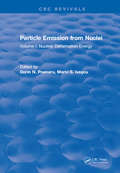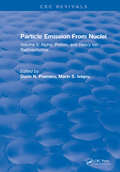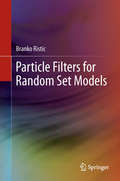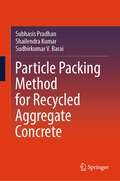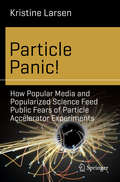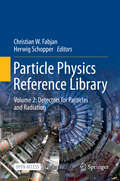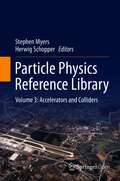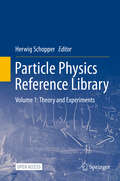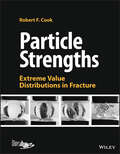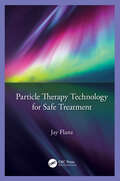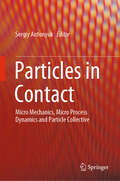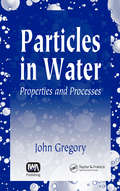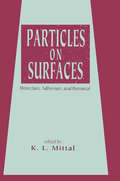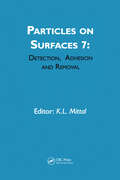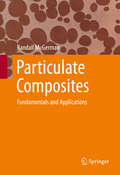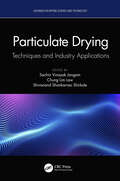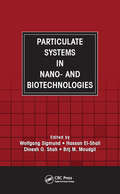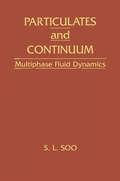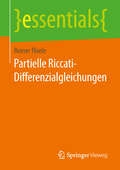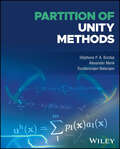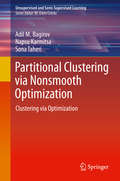- Table View
- List View
Particle Confinement in Penning Traps: An Introduction (Springer Series on Atomic, Optical, and Plasma Physics #126)
by Manuel VogelThis second edition is an updated and extended introduction to the world of Penning traps and provides an overview of the field, particularly for those entering it. The book presents the basics of Penning traps from a fundamental and applied point of view and discusses the variety of methods, technologies and their applications to experiments, particularly in the field of precision spectroscopy across all frequency ranges. The book is written from an experimentalist's point of view, it includes numerous new illustrations and updated references to the available literature to ensure a high degree of breadth and accessibility.The new edition provides, for instance, a new chapter on particle temperature and cooling, new sections on particle dynamics, g-factor measurements, space charge as a confinement limitation, space charge and resonant particle loss, as well as a section on particle loss mechanisms.
Particle Control for Semiconductor Manufacturing
by DonovanThere is something Alice-in-Wonderlandish about powerful and vital computer systems being shut down by a microscopic mote that a hay-feverist wouldn't sneeze at, but as computer chips get smaller, smaller and smaller particles on their surface have a larger and larger effect on their performance. In
Particle Damping Technology Based Structural Control (Springer Tracts in Civil Engineering)
by Zheng Lu Sami F. Masri Xilin LuThis book presents a systematic introduction to particle damping technologies, which can be used to effectively mitigate seismic-induced and wind-induced vibration in various structures. Further, it offers comprehensive information on the latest research advances, e.g. a refined simulation model based on the discrete element method and a simplified simulation model based on equivalent principles. It then intensively studies the vibration attenuation effects of particle dampers subjected to different dynamic loads; in this context, the book proposes a new damping mechanism and “global’’ measures that can be used to evaluate damping performance.Moreover, the book uses the shaking table test and wind tunnel test to verify the proposed simulation methods, and their satisfactory damping performance is confirmed. To facilitate the practical engineering application of this technology, optimization design guidelines for particle impact dampers are also provided. In closing, the book offers a preliminary exploration of semi-active particle damping technology, which holds great potential for extension to other applications in which the primary system is subjected to non-stationary excitations.
Particle Damping Technology Based Structural Control (Springer Tracts In Civil Engineering)
by Zheng Lu Sami F. Masri Xilin LuThis book presents a systematic introduction to particle damping technologies, which can be used to effectively mitigate seismic-induced and wind-induced vibration in various structures. Further, it offers comprehensive information on the latest research advances, e.g. a refined simulation model based on the discrete element method and a simplified simulation model based on equivalent principles. It then intensively studies the vibration attenuation effects of particle dampers subjected to different dynamic loads; in this context, the book proposes a new damping mechanism and “global’’ measures that can be used to evaluate damping performance. Moreover, the book uses the shaking table test and wind tunnel test to verify the proposed simulation methods, and their satisfactory damping performance is confirmed. To facilitate the practical engineering application of this technology, optimization design guidelines for particle impact dampers are also provided. In closing, the book offers a preliminary exploration of semi-active particle damping technology, which holds great potential for extension to other applications in which the primary system is subjected to non-stationary excitations.
Particle Emission From Nuclei: Volume I: Nuclear Deformation Energy
by Dorin N. PoenaruThis book has three volume. The first volume is mainly devoted to the macroscopic-microscopic theory in its traditional form and extended to very high mass and charge asymmetry. Applications of this theory to the emission of different kinds of charged particles from nuclei are presented in the second volume, where recent experimental achievements in alpha decay, proton, and heavy ion (14C, 24Ne, 28Mg, etc.) radioactivities are also discussed. Experiments on spontaneous fission, fission isomers, and more complex phenomena like particle-accompanied fission,delayed processes: p, a, 2p, t, n, 2n, 3n, and the new mechanism of cold fission (or fission with compact shapes) are described in detail in the third volume.
Particle Emission From Nuclei: Volume III: Fission and Beta-Delayed Decay Modes
by Dorin N. PoenaruThis book has three volume. The first volume is mainly devoted to the macroscopic-microscopic theory in its traditional form and extended to very high mass and charge asymmetry. Applications of this theory to the emission of different kinds of charged particles from nuclei are presented in the second volume, where recent experimental achievements in alpha decay, proton, and heavy ion (14C, 24Ne, 28Mg, etc.) radioactivities are also discussed. Experiments on spontaneous fission, fission isomers, and more complex phenomena like particle-accompanied fission,delayed processes: p, a, 2p, t, n, 2n, 3n, and the new mechanism of cold fission (or fission with compact shapes) are described in detail in the third volume.
Particle Filters for Random Set Models
by Branko RisticThis book discusses state estimation of stochastic dynamic systems from noisy measurements, specifically sequential Bayesian estimation and nonlinear or stochastic filtering. The class of solutions presented in this book is based on the Monte Carlo statistical method. Although the resulting algorithms, known as particle filters, have been around for more than a decade, the recent theoretical developments of sequential Bayesian estimation in the framework of random set theory have provided new opportunities which are not widely known and are covered in this book. This book is ideal for graduate students, researchers, scientists and engineers interested in Bayesian estimation.
Particle Packing Method for Recycled Aggregate Concrete
by Subhasis Pradhan Shailendra Kumar Sudhirkumar V. BaraiThis book highlights the use of commercially available recycled aggregate concrete (RAC) extracted from multiple construction and demolition sites, considering it as a viable alternative to conventional aggregate. It further describes the advanced techniques, such as, scanning electron microscopy, nanoindentation, thermogravimetric analysis and X-ray microtomography shedding light on the deep-rooted causes of inferior macro-mechanical performance of RAC and the advantages of particle packing method design approach in this regard. It then describes the improved properties of RAC with the help of macro-mechanical performance studies, microstructural characterization and fracture analysis. The systematic and in-depth presentation of the use of recycled coarse aggregate as an alternative to conventional aggregate for the preparation of structural concrete will guide researchers on subsequent research in RAC and provide assistance to structural engineers and concrete manufacturers for the usage of RAC.
Particle Panic!: How Popular Media and Popularized Science Feed Public Fears of Particle Accelerator Experiments (Science and Fiction)
by Kristine LarsenFrom novels and short stories to television and film, popular media has made a cottage industry of predicting the end of the world will be caused by particle accelerators. Rather than allay such fears, public pronouncements by particle scientists themselves often unwittingly fan the flames of hysteria. This book surveys media depictions of particle accelerator physics and the perceived dangers these experiments pose. In addition, it describes the role of scientists in propagating such fears and misconceptions, offering as a conclusion ways in which the scientific community could successfully allay such misplaced fears through more effective communication strategies. The book is aimed at the general reader interested in separating fact from fiction in the field of high-energy physics, at science educators and communicators, and, last but not least, at all scientists concerned about these issues. About the Author Kristine M Larsen holds a Ph.D. in Physics and is currently a professor at Central Connecticut State University, New Britain, CT, in the Geological Sciences Department. She has published a number of books, among them The Women Who Popularized Geology in the 19th Century (Springer, 2017), The Mythological Dimensions of Neil Gaiman (eds. Anthony Burdge, Jessica Burke, and Kristine Larsen. Kitsune Press, 2012. Recipient of the Gold Medal for Science Fiction/Fantasy in the 2012 Florida Publishing Association Awards), The Mythological Dimensions of Doctor Who (eds. Anthony Burdge, Jessica Burke, and Kristine Larsen. Kitsune Press, 2010), as well as Stephen Hawking: A Biography (Greenwood Press, 2005) and Cosmology 101 (Greenwood Press, (2007).
Particle Physics Reference Library: Volume 2: Detectors for Particles and Radiation
by Christian W. Fabjan Herwig SchopperThis second open access volume of the handbook series deals with detectors, large experimental facilities and data handling, both for accelerator and non-accelerator based experiments. It also covers applications in medicine and life sciences. A joint CERN-Springer initiative, the “Particle Physics Reference Library” provides revised and updated contributions based on previously published material in the well-known Landolt-Boernstein series on particle physics, accelerators and detectors (volumes 21A,B1,B2,C), which took stock of the field approximately one decade ago. Central to this new initiative is publication under full open access.
Particle Physics Reference Library: Volume 3: Accelerators and Colliders
by Stephen Myers Herwig SchopperThis third open access volume of the handbook series deals with accelerator physics, design, technology and operations, as well as with beam optics, dynamics and diagnostics. A joint CERN-Springer initiative, the “Particle Physics Reference Library” provides revised and updated contributions based on previously published material in the well-known Landolt-Boernstein series on particle physics, accelerators and detectors (volumes 21A,B1,B2,C), which took stock of the field approximately one decade ago. Central to this new initiative is publication under full open access
Particle Physics Reference Library: Volume 1: Theory and Experiments
by Herwig SchopperThis first open access volume of the handbook series contains articles on the standard model of particle physics, both from the theoretical and experimental perspective. It also covers related topics, such as heavy-ion physics, neutrino physics and searches for new physics beyond the standard model. A joint CERN-Springer initiative, the “Particle Physics Reference Library” provides revised and updated contributions based on previously published material in the well-known Landolt-Boernstein series on particle physics, accelerators and detectors (volumes 21A,B1,B2,C), which took stock of the field approximately one decade ago. Central to this new initiative is publication under full open access.
Particle Strengths: Extreme Value Distributions in Fracture
by Robert F. CookParticle Strengths A holistic and straightforward analysis framework for understanding particle strength distributions In Particle Strengths: Extreme Value Distributions in Fracture, distinguished researcher Dr. Robert F. Cook delivers a thorough exploration of the science and related engineering of fracture strength distributions of single particles tested in diametral compression. In the book, the author explains particle strengths in the broader context of material strengths to permit readers to design with particles in systems in which mechanical properties are crucial to application, manufacturing, and handling. Particle Strengths compiles published data on particle strengths into a common format that includes over 140 materials systems and over 270 published strength distributions derived from over 13000 individual particle strength measurements. It offers physically consistent descriptions of strength behavior, including the strength threshold, using simple polynomial distribution functions that can easily be implemented. Readers will also find: A thorough introduction to particles and particle loading, including discussions of particle failure and human activity Comprehensive explorations of stochastic scaling of particle strength distributions, including concave and sigmoidal stochastic distributions Practical discussions of agglomerate particle strengths, including those relevant to pharmaceuticals, foods, and catalysts Detailed treatments of applications and scaling of particle strengths, including particle crushing energy and grinding particle reliability Perfect for materials scientists and engineers, mining and construction engineers, and environmental scientists, Particle Strengths: Extreme Value Distributions in Fracture will also benefit anthropologists, zoologists, pharmaceutical scientists, biomaterials scientists and engineers, and graduate students studying materials science, and chemical, mechanical, and biomedical engineering.
Particle Therapy Technology for Safe Treatment
by Jay FlanzThe path from clinical requirements to technical implementation is filtered by the translation of the modality to the technology. An important part of that filter is that the modality be safe. For that to be the case, it is imperative to understand what clinical parameters affect the safety of a treatment and then determine how the technology can affect those parameters. This book provides a practical introduction to particle therapy. It provides a thorough introduction to the technological tools and their applications and then details the components that are needed to implement them. It explains the foundations of beam production and beam delivery that serve to meet the necessary clinical requirements. It emphasizes the relationship between requirements and implementation, including how safety and quality are considered and implemented in the solution. The reader will learn to better understand what parameters are important to achieve these goals. Particle Therapy Technology for Safe Treatment will be a useful resource for professionals in the field of particle therapy in addition to biomedical engineers and practitioners in the field of beam physics. It can also be used as a textbook for graduate medical physics and beam physics courses. Key Features Presents a practical and accessible journey from application requirements to technical solutions Provides a pedagogic treatment of the underlying technology Describes how safety is to be considered in the application of this technology and how safety and quality can be factored into the overall system Author Bio After receiving his PhD in nuclear physics, Dr. Jacob Flanz was the Accelerator Physics Group leader and Principal Research Scientist at the Massachusetts Institute of Technology (MIT), USA, where he designed the recirculator and the GeV stretcher/storage ring. He joined Massachusetts General Hospital (MGH) and Harvard and became project and technical director of proton therapy, with responsibility for specifications, integration, and commissioning ensuring safe clinical performance. He invented the universal nozzle and led the design and implementation of beam scanning at MGH in 2008, including quality assurance. Dr. Flanz has been involved in several FDA applications for particle therapy. He developed and taught the US Particle Accelerator School course "Medical Applications of Accelerators and Beams." He was cochair of education and is currently the president of the Particle Therapy Co-Operative Group.
Particles in Contact: Micro Mechanics, Micro Process Dynamics and Particle Collective
by Sergiy AntonyukThis book contains the latest scientific findings in the area of granular materials, their physical fundamentals and applications in particle technology focused on the description of interactions of fine adhesive particles.In collaboration between physicists, chemists, mathematicians and mechanics and process engineers from 24 universities, new theories and methods for multiscale modeling and reliable measurement of particles are developed, with a focus on:• Basic physical-chemical processes in the contact zone: particle-particle and particle-wall contacts,• Particle collisions and their dynamics• Constitutive material laws for particle systems on the macro level.
Particles in Water: Properties and Processes
by John GregoryBased on the author‘s more than 35 years of experience, Particles in Water: Properties and Processes examines particles and their behavior in water systems. The book offers clear and accessible methods for characterizing a range of particles both individually and as aggregates. The author delineates the principles for understanding particle
Particles on Surfaces: Detection: Adhesion, and Removal
by K. L. MittalThis work comprises the proceedings of the Fourth Symposium on Particles on Surfaces. Papers cover: adhesion-induced deformations of particles on surfaces; the use of atomic force microscopy in probing particle-particle adhesion; particle contamination in microelectronics, on spacecraft, and on optical surfaces; the role of air ionization in reducing surface contamination by particles in the cleanroom; abrasive blasting media for contamination-free deburring processes; and more.;The book is intended for physical, chemical, surface and colloid chemists, materials scientists; polymers, plastics, electrical and electronics, computer, chemical and mechanical engineers; and upper-level undergraduate and graduate students in these disciplines.
Particles on Surfaces: Detection, Adhesion And Removal
by K. L. MittalThis volume documents the proceedings of the 7th International Symposium on Particles on Surfaces: Detection, Adhesion and Removal held in Newark, NJ, June 19-21, 2000. The study of particles on surfaces is extremely important in a host of diverse technological areas, ranging from microelectronics to optics to biomedical. This volume contains a total of 28 papers, which were all properly peer reviewed, revised and edited before inclusion. Therefore, this book is not merely a collection of unreviewed manuscripts, but rather represents information which has passed peer scrutiny. Furthermore, the authors were asked to update their manuscripts, so the information contained in this book should be current and fresh. This volume is divided into two parts: 1) Particle Analysis and General Cleaning-Related Topics; and 2) Particle Adhesion and Removal. The topics covered include: surface analysis techniques for particle identification; cleaning, rinsing and drying issues in post-CMP cleaning; fundamental forces involved in particle adhesion; factors affecting adhesion of small (nanosize) particles; factors important in particle detachment; particle adhesion measurement by AFM; various (wet and dry) techniques for particle removal, e.g., laser, ultrasonic, megasonic, use of surfactants; toner particles and pharmaceutical particles. This volume offers a wealth of information on the tremendously technologically important field of particles on surfaces and should provide a consolidated source of current R&D activity in this arena. Therefore, it will be of value and use to anyone interested in the topic of particles on surfaces.
Particulate Composites
by Randall M. GermanThis book is focused on composites involving powders as the starting materials. It provides relevant information for questions related to the selection of constituent phases, most economic fabrication routes, proper testing procedures, and product optimization. The field is sufficiently advanced that predictive models guide many decisions. Applications are illustrated over a broad range of material and property combinations. This title includes: *Selection of phases with consideration of intersolubility & interface *Microstructure, especially the role of phase connectivity *Fabrication approaches, especially net-shape consolidation *Assessment of typical properties, testing techniques & industry standards *Design & trade-off decisions involved in optimization, including cost *Applications, both those that have matured and some emerging prospects. The reader may have little appreciation for how particulate composites are literally everywhere. Examples include new wear resistant consumer products(Apple watch), longer lasting automotive tires with reduced rolling resistance(Yokohama tires), and new diamond heat sinks for computers(Element Six substrates). Particulate composites also form critical components in applications such as magnets, dental fillings, brakes, darts, bio-implants, & cutting tools. Particulate composites are a multi-billion dollar industry, and can be a cost-effective solution ripe for innovation and continued rapid growth. For the engineer, the wide range of particulate composite formulation and property combinations offers the ability to design for a variety of application and provides ample opportunity for innovation. Particulate Composites: Fundamentals & Applications is ideal for use in a one-semester eng. course at the senior UG/graduate level, and is also suitable as a practical reference for materials scientists in academia and industry.
Particulate Drying: Techniques and Industry Applications (Advances in Drying Science and Technology)
by Sachin Vinayak Jangam Chung Lim Law Shivanand Shankarrao ShirkoleIn the process industry, understanding the unit operation of particulate drying is imperative to yield products with desired properties and characteristics and to ensure process safety, optimal energy efficiency and drying performance, as well as low environmental impact. There are many techniques and tools available, which can cause confusion. Particulate Drying: Techniques and Industry Applications provides an overview of various particulate drying techniques, their advantages and limitations, industrial applications, and simple design methods. This book: • Covers advances in particulate drying and their importance in the process industry • Highlights recent developments in conventional drying techniques and new drying technologies • Helps readers gain insight into selecting the appropriate drying techniques for a particular product • Summarizes various applications from a wide range of industries, including chemical, food, pharmaceutical, biotech, polymer, mineral, and agro-industries • Projects future research trends and demands in particulate drying This book serves as a reference for process and plant engineers as well as researchers in the fields of particulate processing, mineral processing, food processing, chemical engineering, and mechanical engineering, especially those involved in the selection of drying equipment for particulate solids and R&D of drying of particulate materials.
Particulate Systems in Nano- and Biotechnologies
by Brij M. Moudgil Wolfgang Sigmund Hassan El-Shall Dinesh O. ShahDespite the widespread growth and acceptance of particulate technology, challenges in the design, operation, and manufacturing of these systems still exists. These critical issues must be resolved so that particle technology may continue to serve as a foundation for new nano and biotechnologies. Particulate Systems in Nano- and Biotechnologies pres
Particulates And Continuum-Multiphase Fluid Dynamics: Multiphase Fluid Dynamics
by Shao L. SooTreating multiphase systems with emphasis on the aspect of fluid dynamics and as an introduction to research in multiphase flow, this book covers definitive concepts, methods, and theories which have been validated by experimental results. A textbook for college seniors and graduate students and a research reference, it is a coherent presentation that facilitates the understanding of physical interactions. The book's focus is fluid dynamics, with extension to other transport processes of heat and mass transfer, and chemical relations to illustrate applications of multiphase flow. The exercise problems at the end of each chapter assist the reader in formulating and solving physical problems and gaining a sense of magnitude of interacting effects and events. Extended details and corollaries are also included in these exercise problems. Some of the topics in the exercise problems may also be incorporated as topics for the lectures.
Partielle Riccati-Differenzialgleichungen (essentials)
by Reiner ThieleReiner Thiele leitet die Lösungen partieller Riccati-Differenzialgleichungen her und zeigt den Zusammenhang zwischen allgemeinem Integral und singulärer Lösung auf. Dazu appliziert er eine neue Zerlegungsmethode dieser nichtlinearen Differenzialgleichungen (DGL) in jeweils zwei lineare Gleichungen. Nach der Bestimmung der Eigenwerte liegen die Lösungen vor, die bei Faraday-Effekt-Stromsensoren auftreten und durch eine lineare Beziehung zwischen Messgröße und Messwert gekennzeichnet sind. Praxisrelevante Beispiele für Messgrößen und Messwerte beweisen die große Applikationsbreite der patentierten Faraday-Effekt-Stromsensoren des Autors.Der AutorProf. Dr.-Ing. Reiner Thiele lehrte an der Hochschule Zittau/Görlitz und lehrt an der Staatlichen Studienakademie Bautzen.
Partition of Unity Methods
by Stéphane P. Bordas Alexander Menk Sundararajan NatarajanPARTITION OF UNITY METHODS Master the latest tool in computational mechanics with this brand-new resource from distinguished leaders in the field While it is the number one tool for computer aided design and engineering, the finite element method (FEM) has difficulties with discontinuities, singularities, and moving boundaries. Partition of unity methods addresses these challenges and is now increasingly implemented in commercially available software. Partition of Unity Methods delivers a detailed overview of its fundamentals, in particular the extended finite element method for applications in solving moving boundary problems. The distinguished academics and authors introduce the XFEM as a natural extension of the traditional finite element method (FEM), through straightforward one-dimensional examples which form the basis for the subsequent introduction of higher dimensional problems. This book allows readers to fully understand and utilize XFEM just as it becomes ever more crucial to industry practice. Partition of Unity Methods explores all essential topics on this key new technology, including: Coverage of the difficulties faced by the finite element method and the impetus behind the development of XFEM The basics of the finite element method, with discussions of finite element formulation of linear elasticity and the calculation of the force vector An introduction to the fundamentals of enrichment A revisitation of the partition of unity enrichment A description of the geometry of enrichment features, with discussions of level sets for stationary interfaces Application of XFEM to bio-film, gradient theories, and three dimensional crack propagation Perfect for researchers and postdoctoral candidates working in the field of computational mechanics, Partition of Unity Methods also has a place in the libraries of senior undergraduate and graduate students working in the field. Finite element and CFD analysts and developers in private industry will also greatly benefit from this book.
Partitional Clustering via Nonsmooth Optimization: Clustering via Optimization (Unsupervised and Semi-Supervised Learning)
by Napsu Karmitsa Sona Taheri Adil M. BagirovThis book describes optimization models of clustering problems and clustering algorithms based on optimization techniques, including their implementation, evaluation, and applications. The book gives a comprehensive and detailed description of optimization approaches for solving clustering problems; the authors' emphasis on clustering algorithms is based on deterministic methods of optimization. The book also includes results on real-time clustering algorithms based on optimization techniques, addresses implementation issues of these clustering algorithms, and discusses new challenges arising from big data. The book is ideal for anyone teaching or learning clustering algorithms. It provides an accessible introduction to the field and it is well suited for practitioners already familiar with the basics of optimization.
